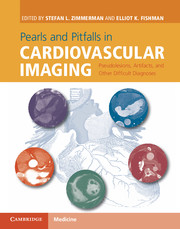 Pearls and Pitfalls in Cardiovascular Imaging
Pearls and Pitfalls in Cardiovascular Imaging from Section 7 - Acute aorta and aortic aneurysms
Published online by Cambridge University Press: 05 June 2015
Imaging description
Ductus diverticulum (DD) is an anatomic variant incidentally found at cardiovascular imaging characterized by a smooth bulge of the anterior wall of the aorta at the aortic isthmus, just distal to the origin of the left subclavian artery.
DD is best visualized on sagittal oblique reconstructions on CT, MRI, or digital subtraction angiography (DSA) (Figures 57.1 and 57.2). DD may be difficult to appreciate on standard axial images. On reconstructions, it is recognized as an anteriorly directed bulge of the undersurface of the aortic arch that extends to the proximal descending thoracic aorta. DD has smooth, gentle margins, and obtuse shoulders.
Importance
DD must not be confused with traumatic aortic transection or ductus arteriosus aneurysm, both of which can occur at the same location and have a greater risk of morbidity and mortality.
Typical clinical case scenario
DD is typically encountered as an incidental finding on CT, MR or DSA and is of no clinical significance. It occurs in approximately 26% of adults and requires no follow-up or treatment.
Differential diagnosis
Traumatic aortic transection, also known as post-traumatic pseudoaneurysm, is found in patients with a history of highvelocity trauma. At cross-sectional imaging, aortic transections arise from the anterior wall of the aorta at the isthmus, similar to DD. However, aortic transections have acute angles with the aortic wall, are irregular in shape and size, and often have a visible intimal flap (Figure 57.3). There may be a narrow neck that communicates with the aorta. Associated periaortic and mediastinal hematoma are typically present with traumatic aortic transection.
Aneurysm of the ductus arteriosus is a rare entity characterized by a saccular aneurysm of the undersurface of the aortic arch in the region of the ductus arteriosus (Figure 57.4). Wall calcifications and partial thrombosis are frequently present. Some believe this entity is due to incomplete obliteration of the patent ductus arteriosus during early development that results in a blind-ending stump communicating with the aortic lumen. Progressive enlargement occurs over years.
To save this book to your Kindle, first ensure no-reply@cambridge.org is added to your Approved Personal Document E-mail List under your Personal Document Settings on the Manage Your Content and Devices page of your Amazon account. Then enter the ‘name’ part of your Kindle email address below. Find out more about saving to your Kindle.
Note you can select to save to either the @free.kindle.com or @kindle.com variations. ‘@free.kindle.com’ emails are free but can only be saved to your device when it is connected to wi-fi. ‘@kindle.com’ emails can be delivered even when you are not connected to wi-fi, but note that service fees apply.
Find out more about the Kindle Personal Document Service.
To save content items to your account, please confirm that you agree to abide by our usage policies. If this is the first time you use this feature, you will be asked to authorise Cambridge Core to connect with your account. Find out more about saving content to Dropbox.
To save content items to your account, please confirm that you agree to abide by our usage policies. If this is the first time you use this feature, you will be asked to authorise Cambridge Core to connect with your account. Find out more about saving content to Google Drive.